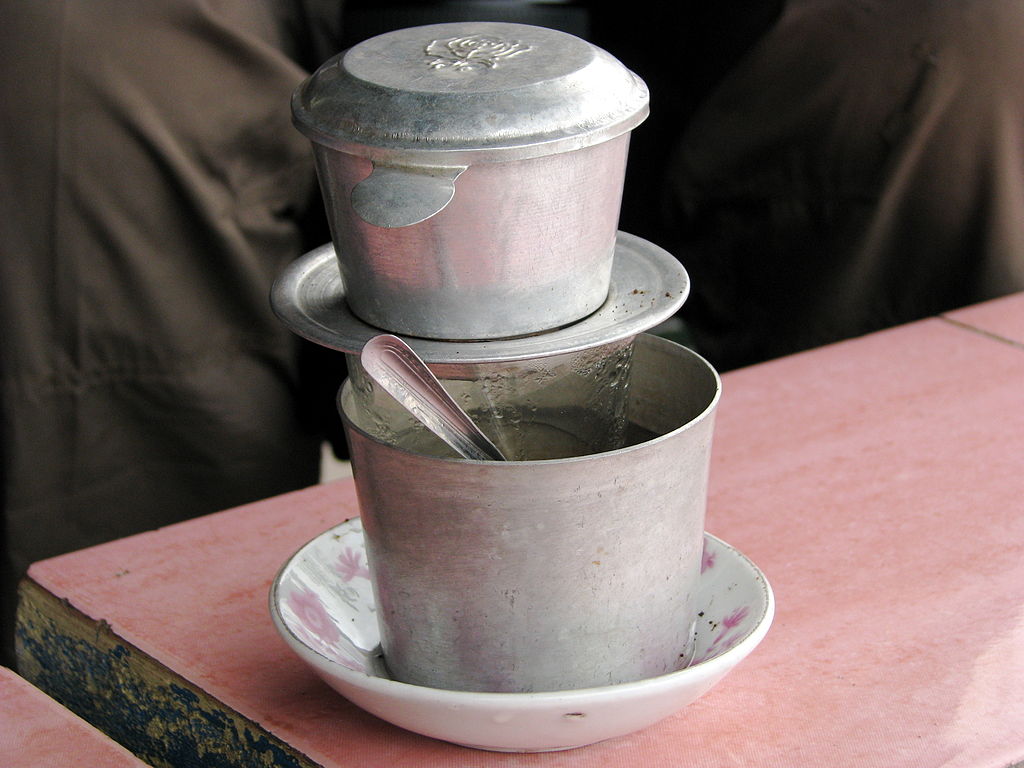When I had taken my first sip, I knew that I had crossed the next threshold of caffeine Nirvana. The fusion of sweetness, creaminess and caffeine swirled in my mouth, awakening my senses to this new and enlightening sensation.
I was in Chicago many years ago and after finishing dinner at the renowned French-Vietnamese restaurant, Le Colonial, our group decided to conclude with coffee. One of my friends suggested we do something more exotic than regular coffee. So what mysterious drink provided a coffee revelation? The Southeast Asia staple of Vietnamese coffee. Vietnamese coffee is as much fun to make as it is to watch, a real treat, especially for those who enjoy their coffee strong and sweet.
(Originally published in the Summer 2010 issue of Food & Dining)
Imagine a short glass with a hard dose of sweetened condensed milk, the color of ivory and the texture of hot fudge. The glass wears a metal top hat, a filter with grounds and water, which dribbles drops of thick coffee, crude-oil black and nearly as bitter, into the lower level. They sit, stacked in two layers, until you take a spoon and give it a turn. For a moment, the coffee and milk swirl around each other, hesitating before coming together, a phenomenon smarter people than I call sensitive chaos. You take a sip, and the sweetness hits first, full and rich. Then your mouth dries a bit, like the tide pulling back, and coffee leaves a mellow bitterness. You take another sip, and suddenly everything is right with the world.
The French brought coffee to Vietnam in the 1800s, taking advantage of the climate to create massive coffee plantations. Historically, Vietnam is one of the most important countries involved in coffee cultivation, and today is the world’s second largest producer of coffee (second to Brazil), a fact that comes as a surprise to most coffee consumers. Despite bumper crops, it wasn’t exactly a café au lait party: Vietnam was not home to a dairy-drinking culture. It was a tough place to find fresh milk, and whatever there was wouldn’t last in the heat. Condensed milk was the solution.
Several items are required for you to enjoy this drink firsthand, but trust me, it is definitely worth it.
To make Ca phe sua nong (Vietnamese coffee) you need water, a heat source, a phin (which is a little hat-like contraption), a glass coffee mug, and coffee with chicory.
The last is up to debate, as some people like their brew with straight coffee, but traditionally Vietnamese coffee is made with chicory, which is a caffeine-free herb used to flavor the coffee. Café du Monde, French Market and the Vietnamese coffee Trung Nguyen are popular brands and the grind is perfect for brewing this coffee. Trung Nguyen coffee is unique because the coffee beans are generally roasted in what is referred to as “butter oil,” which may or may not be actual clarified butter oil. Occasionally vegetable oils are used, and historically, traditional “home-grown” coffee roasting style involves creating almost a caramel-like coating effect with the use of a small amount of sugar, oil, and generally a touch of vanilla or cocoa. Some folks don’t like it however and stick with straight coffee.
Start with your glass coffee mug, and pour about a third of an inch of condensed milk in it. It is thick, creamy, sweet, and the heart and soul of your cup of Vietnamese coffee. Remember, it’s condensed milk, not evaporated. It may seem like a small difference, but the two are very different creatures. Condensed milk typically contains sugar and is heat processed with steam. Steamed milk has different physics from non-steamed milk and tastes better when used in coffee (ask any cappuccino drinker). You can use easily available Eagle Brand condensed milk, but I have found the Sua Ong Tho Longevity Brand condensed milk to be a more superior buy. Avoid milks that have the word ‘filled’ on the label — they contain vegetable oil. Check the ingredients!
Get your phin ready by taking the top off and unscrewing the top filter. Then dump three heaping teaspoons of coarse ground coffee and chicory (a French grind should do it). Replace the top filter and tighten the screw so that the top filter is snug against the coffee grounds. Don’t get too enthusiastic and make the filter tight, just aim for snug.
Set the phin on top of your glass coffee cup. Slowly pour hot water into the phin, until it is about one-fourth full. It should take 20 seconds or more for the hot water to filter through. If it takes less time, you need to tighten the screw on your filter. Once you have your filter squared away, fill the phin with hot water and place the cover on top. Let the coffee brew in peace, this should take about five minutes. The liquid should drip out of the phin, not stream.
Once the coffee has stopped dripping, carefully remove the phin and set it aside. You can then either stir the condensed milk into the coffee or leave it for a sweet finish. Vietnamese coffee is also great iced. Enjoy!
The Louisville area has several restaurants that feature Vietnamese coffee for those who aren’t confident enough of their culinary or barista skills to attempt making it at home. August Moon Chinese Bistro, Vietnam Kitchen, Annie Cafe and Lemongrass Café are all excellent and reliable cafés to experience the wonders and subtleties of Vietnamese coffee. If you are adventurous and looking for any of the above items to tackle making this ambrosial drink on your own, you should be able to find them at any Asian market.
The resulting coffee has the texture of a good espresso and a caramel sweetness with a flavor close to good coffee ice cream. This coffee may actually be too strong for some people and it is not unusual to ask for a carafe of hot water to dilute the drink. The marriage of sweet thick milk and intense bitter coffee is sublime. Each, on its own, is too intense to be enjoyed. The milk is too cloying, the coffee too strong. There is a classic yin and yang vying for attention and needing just a stir of the spoon to create an extraordinary balance.
Sip it slowly. The wait is worth it. F&D


























